Longhaired cats, with their flowing fur and graceful demeanor, often evoke images of elegance and sophistication. These feline beauties come in a delightful array of sizes, colors, and temperaments, each breed offering a unique charm. From the majestic fluff of their manes and tails to the adorable tufts of fur between their toes and ears, Longhair Cats possess an undeniable allure. Contrary to common belief, not all longhaired cat breeds demand excessive grooming, making them surprisingly manageable companions for many cat lovers.
Let’s explore some of the most beloved and distinctive longhaired cat breeds, delving into their characteristics and care needs.
Popular Longhaired Cat Breeds
1. Persian Cat
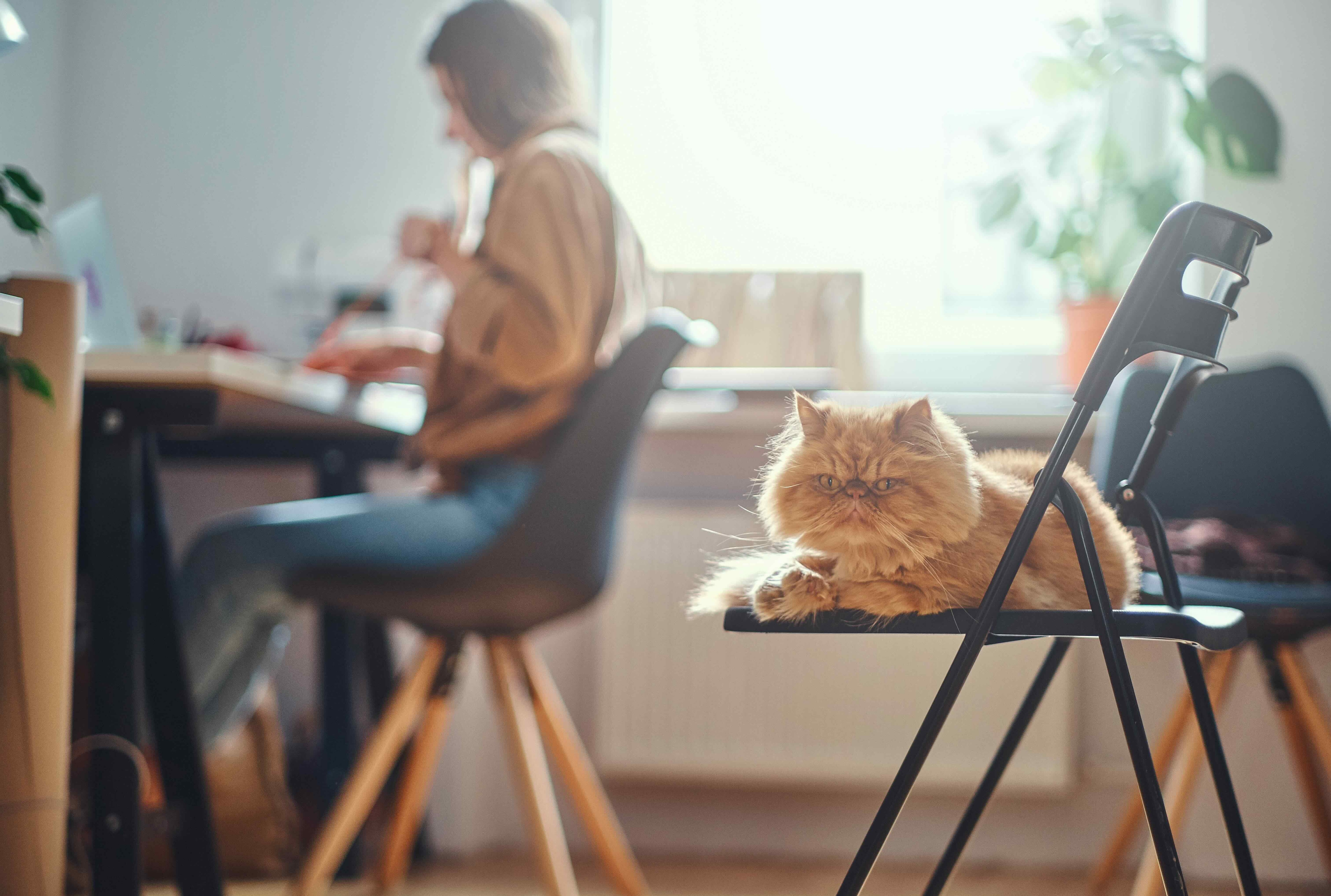 A serene red Persian cat lounges on a chair, with a woman working at a desk in the background. The cat's long, flowing red fur is prominently displayed.
A serene red Persian cat lounges on a chair, with a woman working at a desk in the background. The cat's long, flowing red fur is prominently displayed.
Photo by Adobe Stock/Fxquadro
The Persian cat, instantly recognizable for its luxurious, flowing coat and endearing flat face, stands as one of the quintessential longhaired breeds. Renowned for their gentle and placid nature, Persians thrive in tranquil and peaceful home environments. These felines are known to form deep bonds with their families, expressing affection warmly, though they may initially exhibit reserve towards unfamiliar individuals.
Persians boast a diverse palette of coat colors, encompassing classic shades like black, red, and cream. For those seeking a grey longhair cat, the captivating blue and lilac variations offer unique and sophisticated options. Maintaining the Persian’s magnificent coat necessitates daily grooming. This routine is crucial for preventing matting and keeping their fur and facial area free from debris, ensuring their continued comfort and beauty.
2. Himalayan Cat
 A poised silver colorpoint Himalayan cat sits in lush green grass, gazing upwards with alert expression. The cat's cream body and darker points are clearly visible.
A poised silver colorpoint Himalayan cat sits in lush green grass, gazing upwards with alert expression. The cat's cream body and darker points are clearly visible.
Photo by Adobe Stock/Sherlisa
The Himalayan cat, a delightful blend of Persian and Siamese lineage, inherits the best traits of both breeds: the long, flowing coat of the Persian and the affectionate, playful personality of the Siamese. The Himalayan is easily identified by its striking “points”—areas of darker coloration that adorn the ears, face (mask), paws, and tail.
These points create a beautiful contrast against the Himalayan’s creamy body coat and appear in a spectrum of colors, including seal (a dark brown-black with warm undertones), elegant blue, soft lilac, rich chocolate, and vibrant flame (red-orange). These points can present as solid colors or patterned variations. The Himalayan’s coat texture can range from fine and silky to dense and woolly; regardless of texture, daily brushing is an essential aspect of their grooming regimen to prevent tangles and maintain coat health.
3. LaPerm Cat
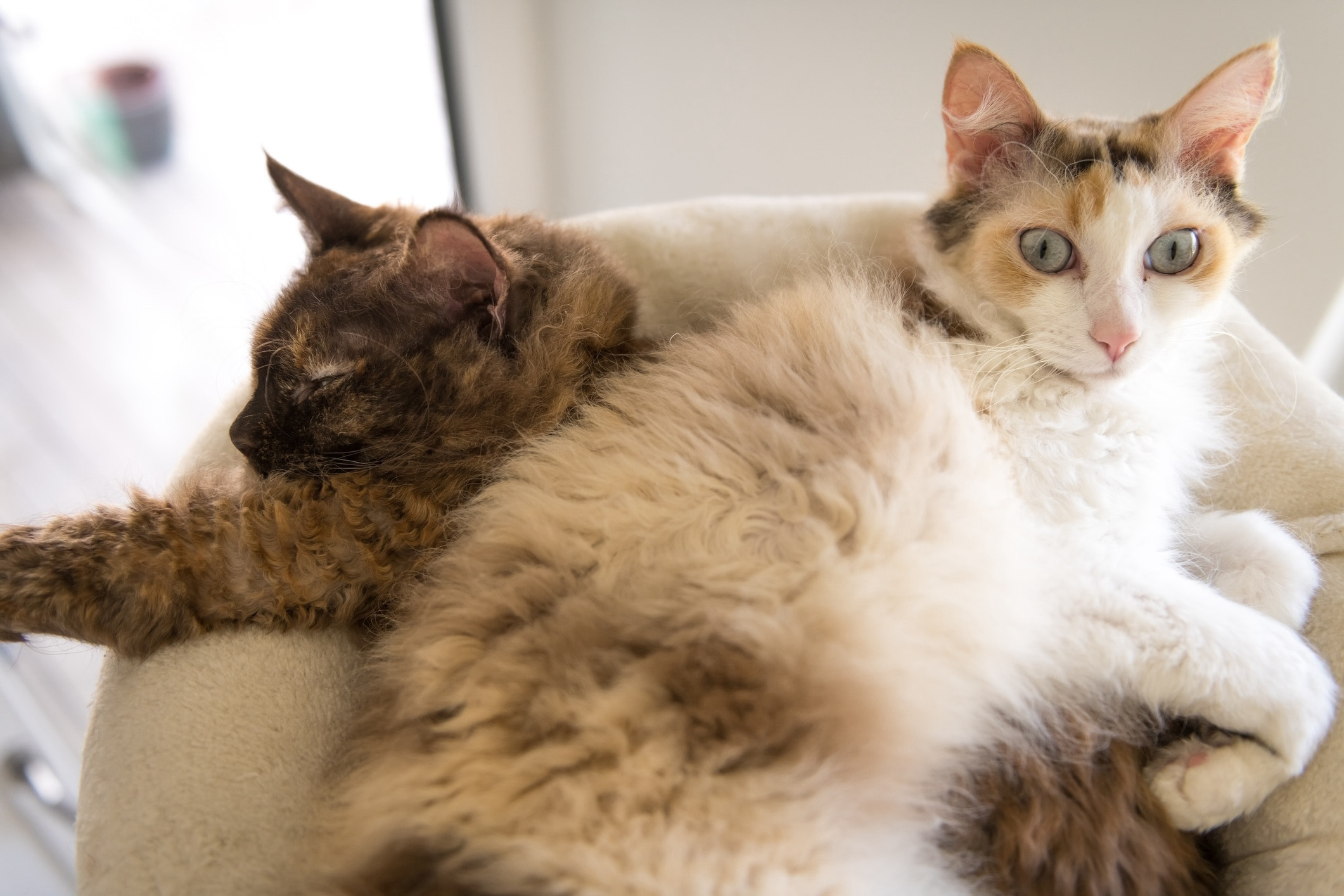 Two adorable LaPerm cats curl up together in a cat tree, showcasing their unique wavy coats. The cats are different colors, one tabby and one solid color.
Two adorable LaPerm cats curl up together in a cat tree, showcasing their unique wavy coats. The cats are different colors, one tabby and one solid color.
Photo by oxico/iStock / Getty Images Plus via Getty Images
The LaPerm cat, a breed celebrated for its distinctive curly coat, offers a truly unique appearance among longhaired felines. This breed’s signature wavy fur arises from a naturally occurring gene mutation, resulting in coats that can be either long or short.
The longhaired LaPerm displays a medium to long coat, characterized by its charming curls and waves. The texture is described as springy and airy by the Cat Fanciers’ Association (CFA), adding to their overall appeal. Despite their luxurious long fur, LaPerms are known for being relatively low-shedding, a surprising benefit for a longhaired breed. Beyond their unique coat, LaPerms are cherished for their affectionate and active personalities, making them engaging and loving companions.
4. Maine Coon Cat
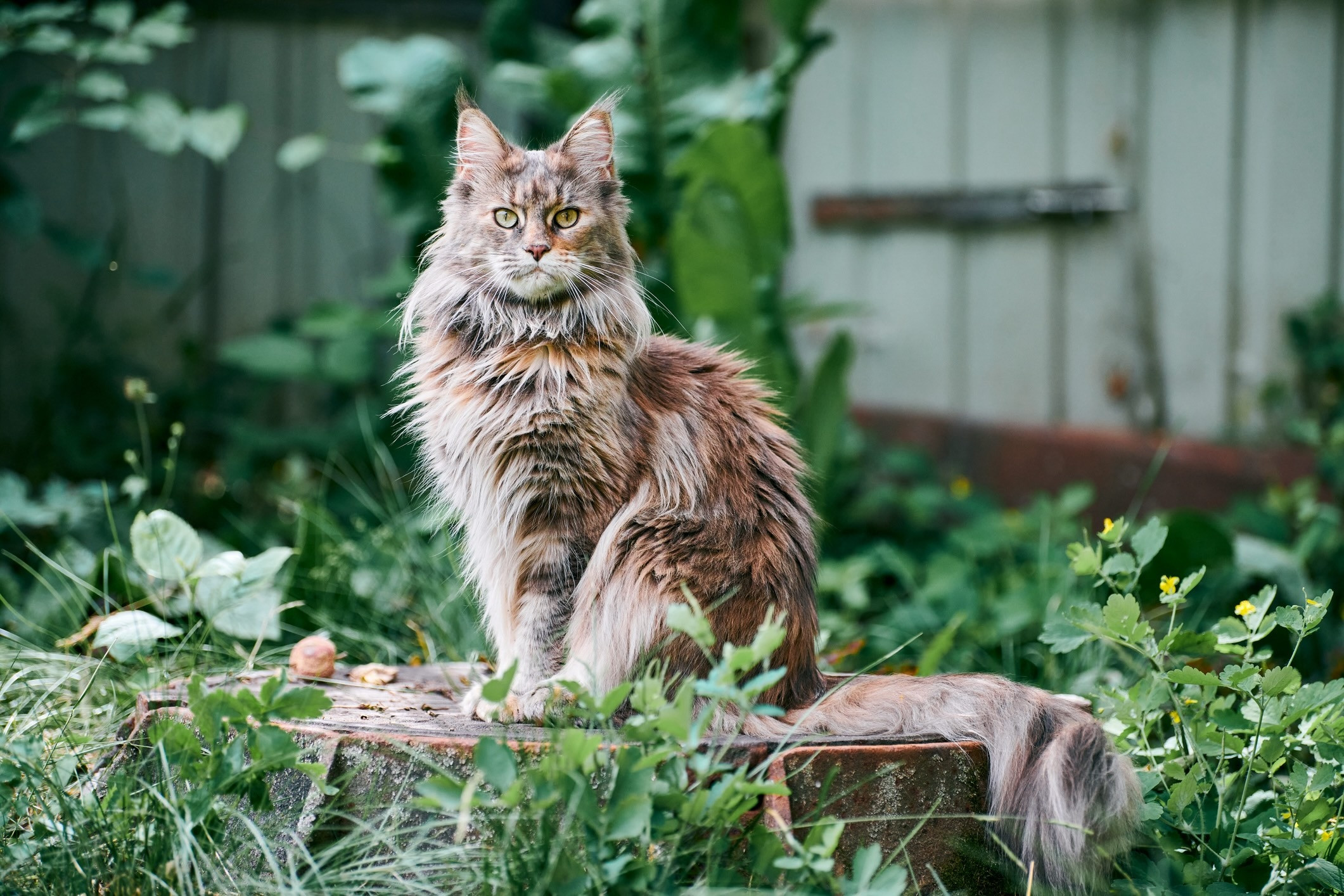 A majestic brown and orange Maine Coon tabby cat sits regally in a garden setting, its large size and long fur are prominent.
A majestic brown and orange Maine Coon tabby cat sits regally in a garden setting, its large size and long fur are prominent.
Photo by TRAVELARIUM/iStock / Getty Images Plus via Getty Images
The Maine Coon, a gentle giant among longhaired cats, commands attention with its impressive size, magnificent long coat, and extraordinarily long whiskers. They are renowned as wonderful companions, known for their affectionate and intelligent nature. Many Maine Coons exhibit almost dog-like qualities, including a playful demeanor and trainability.
As one of the largest longhaired cat breeds, a fully grown Maine Coon can reach a weight of up to 25 pounds. Their dense, double coat requires regular care; brushing a few times per week is essential to keep their fur looking its best and prevent the formation of mats and tangles. This grooming routine helps manage shedding and maintain the health and beauty of their impressive coat.
5. Norwegian Forest Cat
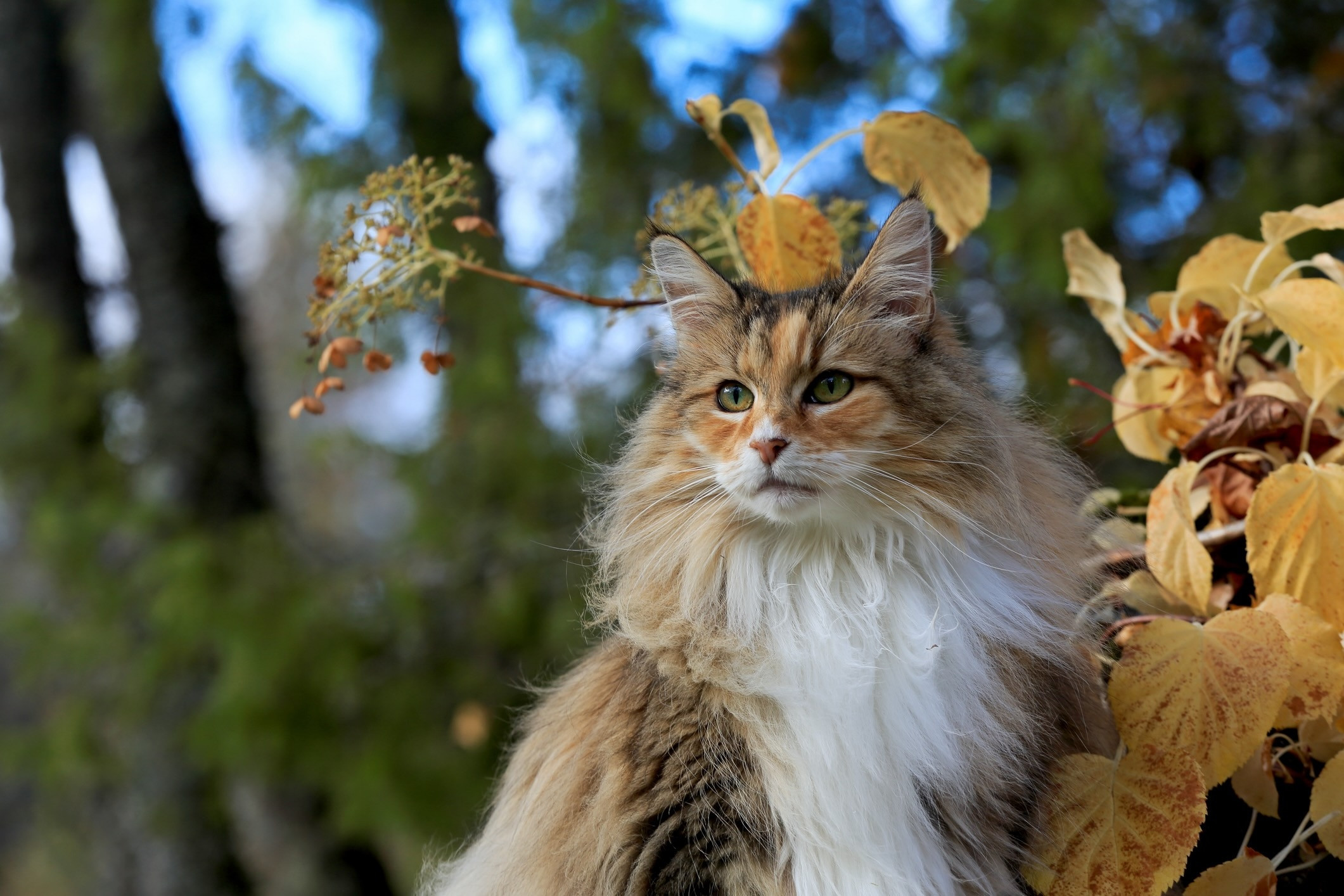 A close-up of a striking white, brown, and orange Norwegian Forest Cat outdoors. The cat's thick fur is clearly visible, designed for cold climates.
A close-up of a striking white, brown, and orange Norwegian Forest Cat outdoors. The cat's thick fur is clearly visible, designed for cold climates.
Photo by undefined undefined/iStock / Getty Images Plus via Getty Images
Another large and powerfully built longhaired cat breed is the Norwegian Forest Cat. These felines evolved with a thick, water-resistant double coat to withstand the harsh winters of their native Scandinavia. This dense fur provides excellent insulation, but it also requires regular grooming. Brushing several times a week is recommended to keep their coat healthy and free of mats.
Twice a year, during shedding season, Norwegian Forest Cats undergo a significant coat change. During these periods, increasing the brushing frequency to daily will be necessary to manage the shedding undercoat and minimize loose fur around the home. Fortunately, the sociable and affectionate nature of this breed makes grooming sessions enjoyable for both cat and owner, as they typically relish the attention and interaction with their human companions.
6. Ragdoll Cat
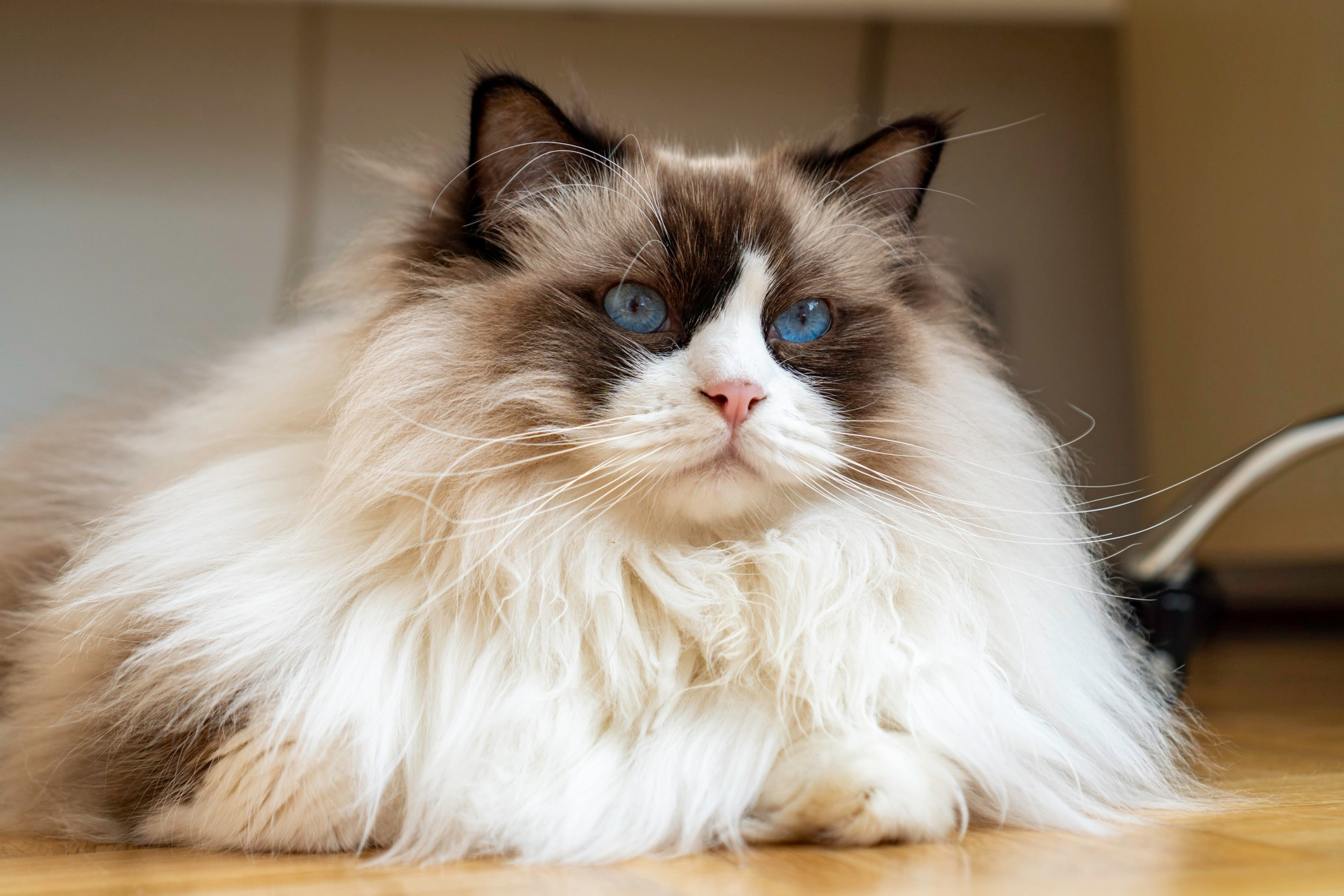 A serene close-up of a longhaired Ragdoll cat lying comfortably on the floor. The cat's relaxed posture and blue eyes are clearly visible.
A serene close-up of a longhaired Ragdoll cat lying comfortably on the floor. The cat's relaxed posture and blue eyes are clearly visible.
Photo by iBennn/iStock / Getty Images Plus via Getty Images
The Ragdoll cat, a breed famed for its exceptionally docile and floppy nature, earns its name from its tendency to go limp and relaxed when held or petted. This endearing trait, combined with their beautiful long coat, makes them a popular choice for families and individuals seeking a gentle and affectionate companion.
Ragdolls are recognized as one of the friendliest cat breeds, thriving on companionship and interaction. They flourish in homes where they receive ample attention, either from other pets or from humans who are frequently present. Beyond their need for social engagement, Ragdolls are relatively easy to care for. Grooming once or twice a week is generally sufficient to maintain their coat’s health and prevent tangles, making them a manageable longhaired breed for many owners.
7. RagaMuffin Cat
The RagaMuffin, closely related to the Ragdoll, shares the same endearing affectionate temperament and strong bond with their human families. This longhaired cat breed is distinguished by its plush, soft, and silky coat, featuring a distinctive ruff around the neck and slightly longer fur on the belly.
Despite its luxurious appearance, the RagaMuffin’s coat is surprisingly low-maintenance. Regular grooming is straightforward; typically, weekly combing is enough to keep their fur in excellent condition, free of mats and tangles. This ease of care, combined with their loving personality, makes the RagaMuffin a delightful longhaired companion.
8. Siberian Cat
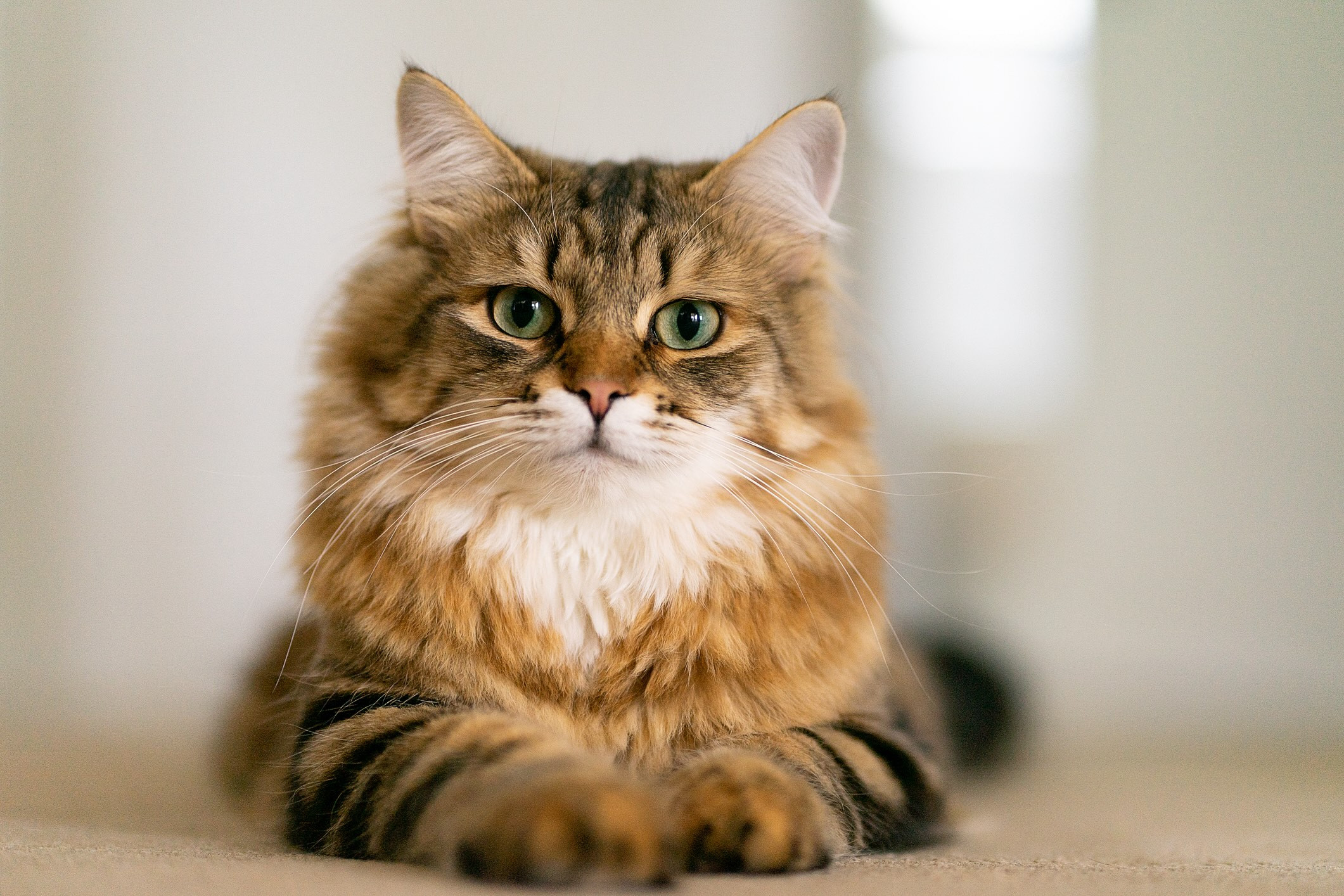 A handsome brown tabby longhaired Siberian cat lies down, looking directly at the camera with a relaxed expression. The cat's thick, layered coat is apparent.
A handsome brown tabby longhaired Siberian cat lies down, looking directly at the camera with a relaxed expression. The cat's thick, layered coat is apparent.
Photo by Julia Gomina/iStock / Getty Images Plus via Getty Images
The Siberian cat stands out among longhaired breeds for possessing a unique triple coat. This luxurious coat consists of guard hair, awn hair, and a dense undercoat, providing exceptional insulation against cold climates. While a triple coat might sound demanding to maintain, Siberian cats are surprisingly low-maintenance in terms of grooming. Weekly brushing is usually sufficient to keep their coat healthy and tangle-free, except during shedding seasons.
During spring and fall shedding periods, more frequent grooming is required. Brushing as often as daily will help manage the shedding undercoat and keep loose fur under control. Siberians are also known for their wonderfully friendly and sociable personalities. They are known to be lap cats, enjoying close contact with their owners, and are also intelligent, active, and trainable, making them engaging and rewarding companions.
9. Selkirk Rex Cat
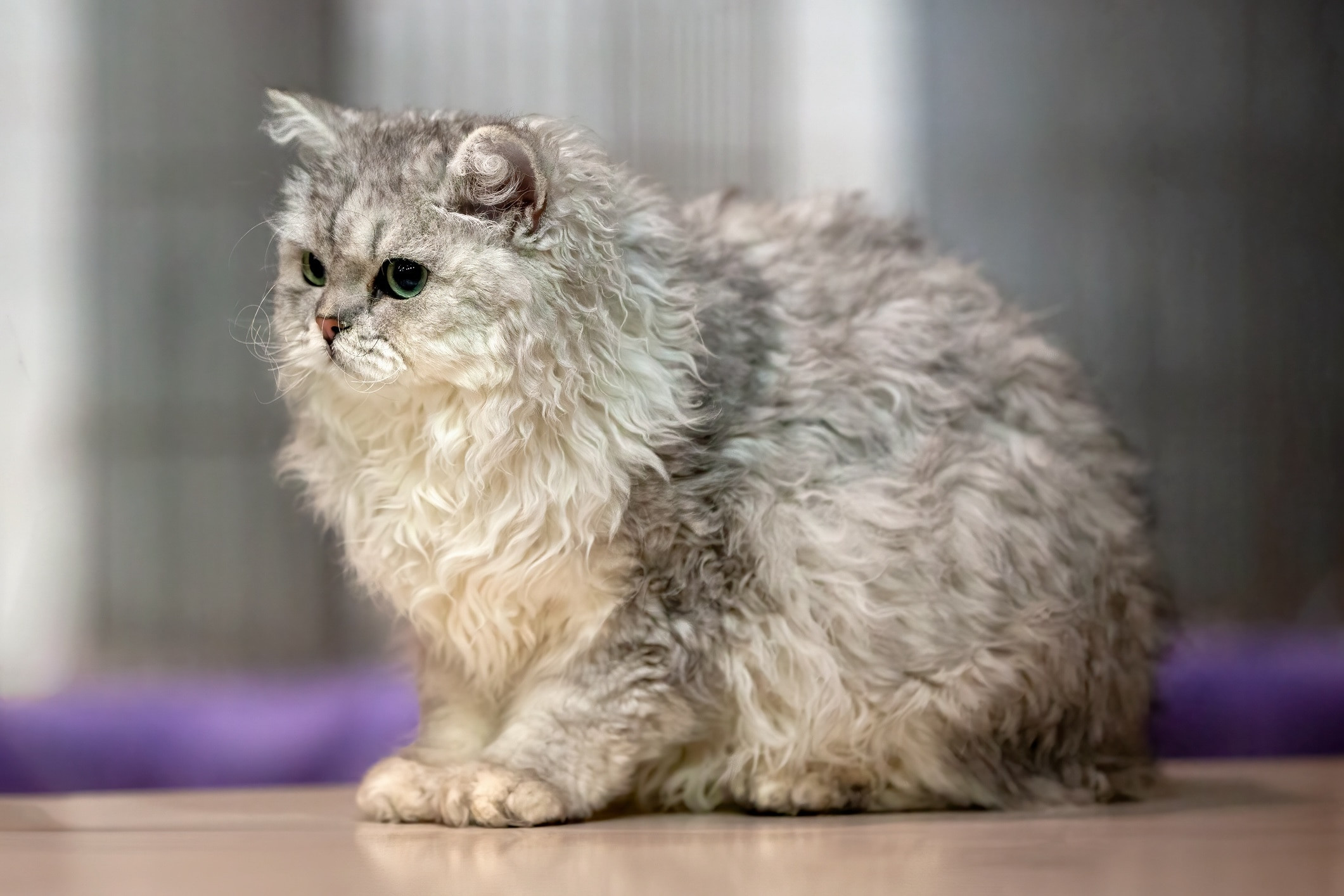 A charming curly-haired Selkirk Rex cat sits on the floor, showcasing its unique and plush curls.
A charming curly-haired Selkirk Rex cat sits on the floor, showcasing its unique and plush curls.
Photo by Sue Thatcher/iStock / Getty Images Plus via Getty Images
The Selkirk Rex is another curly-coated breed, inheriting its distinctive waves from a naturally occurring gene mutation. Adding to their unique charm, longhaired Selkirk Rex cats boast luxuriously long and fluffy fur, a trait stemming from their Persian ancestry. Unlike many long-fur cat breeds, the Selkirk Rex requires a gentler approach to grooming. Over-brushing can disrupt their curls and potentially lead to frizziness.
To maintain their coat’s health and curl pattern, Selkirk Rex cats benefit from semi-regular bathing. They are prone to developing oily skin, and bathing helps to manage this. Establishing a consistent grooming routine, including gentle brushing and bathing, early in a Selkirk Rex’s life will make these processes easier and more comfortable for both cat and owner.
10. American Bobtail Cat
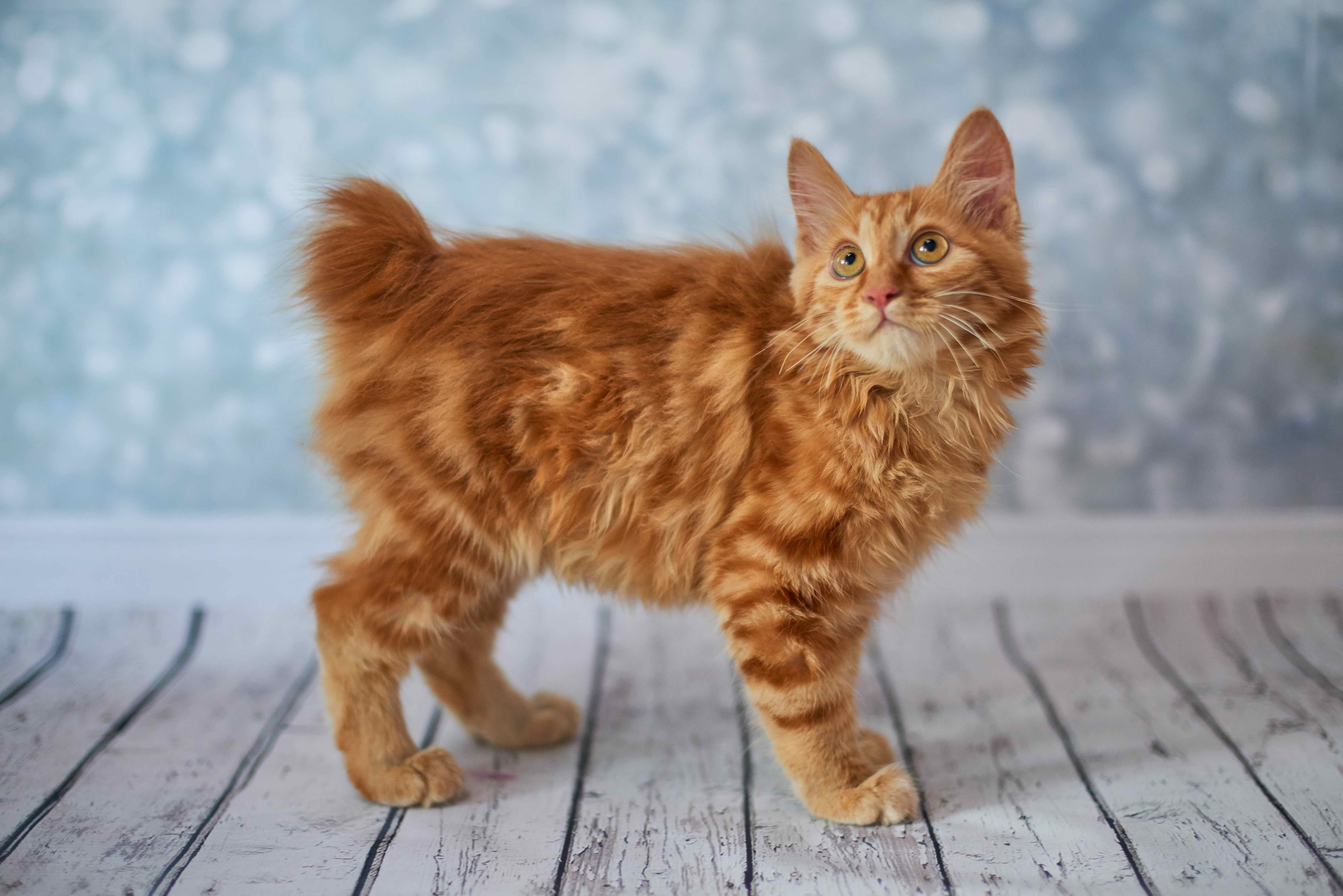 An adorable fluffy red American Bobtail kitten poses for the camera, its short tail and soft fur are highlighted.
An adorable fluffy red American Bobtail kitten poses for the camera, its short tail and soft fur are highlighted.
Photo by Adobe Stock/jane_khomi
The American Bobtail cat is characterized by its shaggy, medium-long coat and, most notably, its short, bobbed tail, which is a defining feature of the breed. The tail length varies but can be as short as just one inch.
According to The International Cat Association (TICA) breed standard, American Bobtails can exhibit any coat color and pattern, resulting in a wide variety of appearances, from fluffy brown cats to striking longhaired orange cats. This medium-sized breed is known for its adaptable and affectionate temperament. They are also intelligent and trainable, capable of learning tricks and enjoying interactive games, making them engaging and versatile pets.
11. Birman Cat
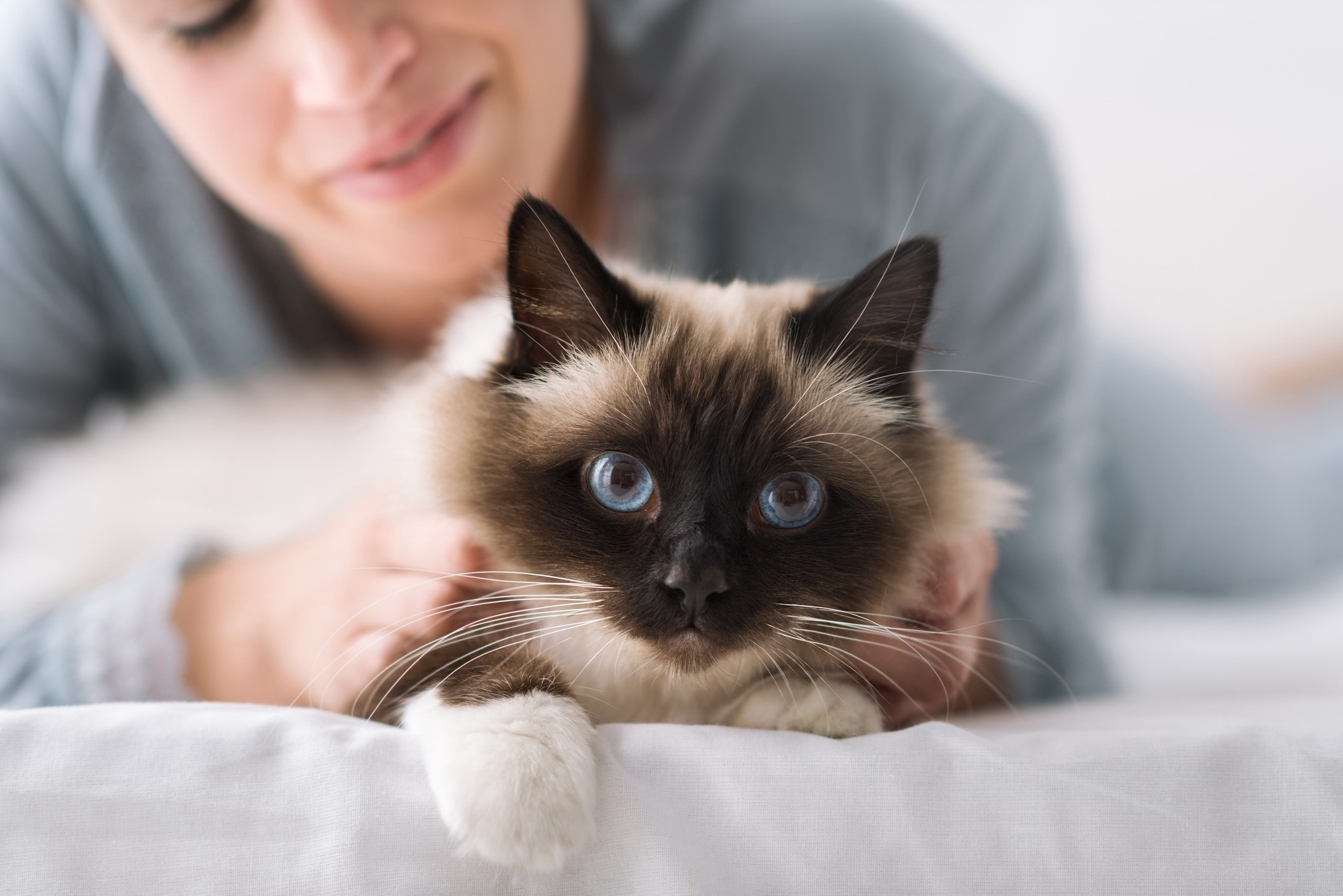 A woman gently pets a beautiful longhaired Birman cat on a bed. The cat looks directly at the camera, showcasing its bright blue eyes and colorpointed coat.
A woman gently pets a beautiful longhaired Birman cat on a bed. The cat looks directly at the camera, showcasing its bright blue eyes and colorpointed coat.
Photo by demaerre/iStock / Getty Images Plus via Getty Images
The Birman cat captivates with its striking bright blue eyes and a distinctive colorpoint coat, which is typically white or cream with darker points on the face, tail, and legs. This breed’s elegant appearance is complemented by a gentle and affectionate nature.
For pet parents who are apprehensive about demanding grooming routines, the Birman offers welcome relief. Their long, silky coat is less prone to tangling and matting compared to some other fluffy breeds. However, brushing a Birman a few times each week remains beneficial to minimize shedding and reduce the likelihood of hairballs, contributing to their overall health and well-being.
12. Japanese Bobtail Cat
The longhaired Japanese Bobtail shares the characteristic short, pom-pom tail of its shorthaired counterpart, with tails no longer than three inches. Their medium to long coat is silky and lacks a prominent undercoat, making it relatively easy to manage. The smooth, fine texture of their fur is kept in good condition with regular weekly brushing.
Japanese Bobtails come in a delightful array of colors, including solid shades, bi-color, and tri-color patterns. Beyond their appealing looks, they are known for their highly interactive and social personalities. Japanese Bobtails are often vocal, readily engaging with their human companions to seek attention and boldly befriending new people, making them lively and engaging family pets.
13. Pixiebob Cat
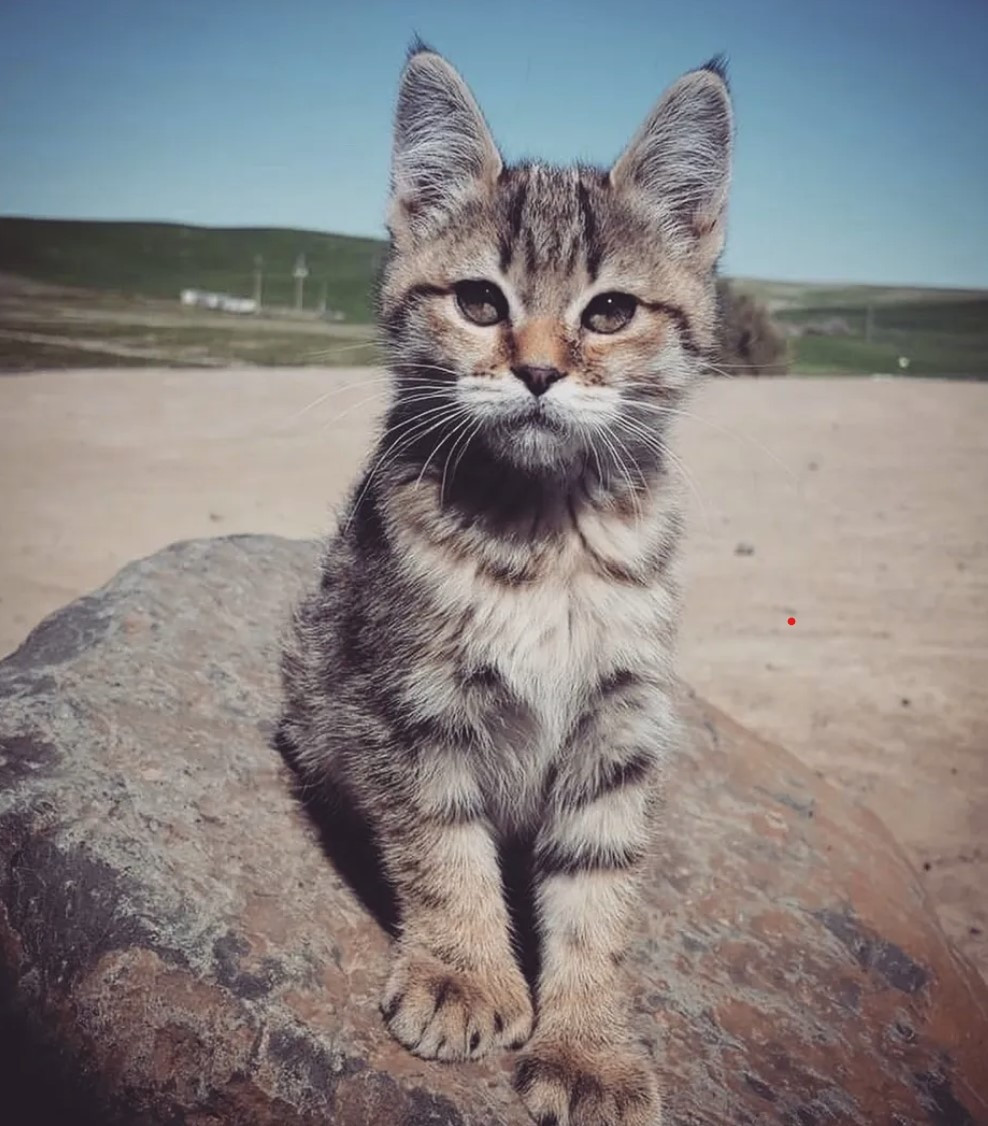 A charming Pixiebob kitten with extra toes sits and looks inquisitively at the camera. The kitten's wild appearance and lynx-like features are evident.
A charming Pixiebob kitten with extra toes sits and looks inquisitively at the camera. The kitten's wild appearance and lynx-like features are evident.
Photo courtesy of Brent and Janda Keenan of Emerald City Exotic Cats
The Pixiebob is intentionally bred to resemble the wild North American bobcat, capturing a slightly wild appearance in a domestic cat. The breed standard acknowledges both shorthaired and longhaired coat variations, describing the facial hair in both types as full and bushy, enhancing their bobcat-like resemblance.
Longhaired Pixiebob cats feature a soft coat that is approximately two inches in length and lies close to the body. Despite their wildcat looks, Pixiebobs possess a surprisingly relaxed and friendly nature, making them excellent house cats. Their adaptable and gentle temperament makes them well-suited to family life.
14. Turkish Angora Cat
 A sleek black Turkish Angora cat lies gracefully on a black background. The cat's silky fur and elegant body shape are highlighted against the dark backdrop.
A sleek black Turkish Angora cat lies gracefully on a black background. The cat's silky fur and elegant body shape are highlighted against the dark backdrop.
Photo courtesy of Kit Goodwin
The Turkish Angora is admired for its smooth, silky coat, which is not only beautiful but also remarkably low-maintenance. Lacking an undercoat, the Turkish Angora’s fur is less prone to matting compared to many other longhaired breeds. While matting is less of a concern, regular brushing a few times per week is still recommended to maintain their coat’s health and shine.
In terms of temperament, Turkish Angoras are not typically known for being overly cuddly compared to some other longhaired breeds. However, they are playful and enjoy active interaction with people and other pets. They are also known to be quite vocal, often expressing themselves through meows and chirps, adding to their engaging personalities.
15. Turkish Van Cat
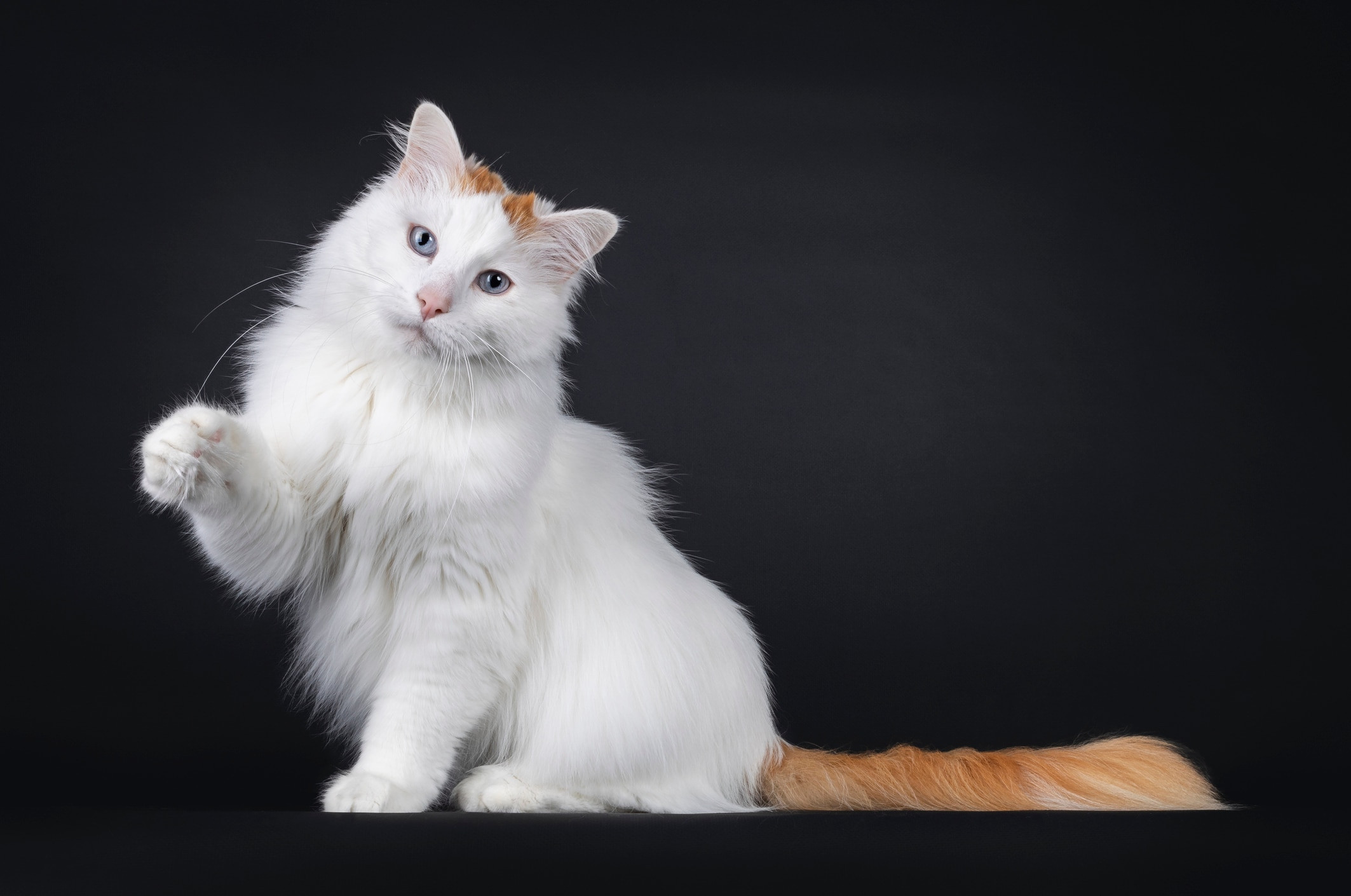 A striking white and orange Turkish Van cat is positioned on a black background. The cat's distinctive color pattern and semi-long fur are clearly displayed.
A striking white and orange Turkish Van cat is positioned on a black background. The cat's distinctive color pattern and semi-long fur are clearly displayed.
Photo by Nynke van Holten/iStock / Getty Images Plus via Getty Images
The Turkish Van is another low-maintenance longhaired cat breed, known for its unique coat development. Interestingly, Turkish Van kittens are born with short coats that gradually grow into their signature semi-long fur coat as they mature, typically reaching full length by 3 to 5 years of age.
Even in adulthood, the Turkish Van’s coat exhibits seasonal changes. They tend to have a shorter coat during the summer months and develop a thicker, longer coat to provide warmth during the winter. Regardless of the season, the Turkish Van is characterized by a full, bushy tail and charming ear tufts, adding to their distinctive appearance.
Caring for Your Longhaired Cat
The fundamental aspects of caring for longhaired cats are consistent with the general needs of all cats. They require a balanced diet with proper nutrition, mental stimulation through play and interaction, and essential provisions such as a clean litter box and engaging cat toys. However, longhaired cat breeds often have more demanding grooming requirements due to their luxurious coats.
Regular brushing is the most crucial aspect of grooming for longhaired cats, alongside routine nail clipping. Investing in a quality comb and brush designed for long fur is essential. These tools will help effectively remove loose fur, eliminate dander, and keep their coats smooth and tangle-free.
Learning the correct techniques for brushing a cat is important to ensure comfort and effectiveness. Making grooming a positive experience is key; offering your cat plenty of affection and tasty treats throughout the grooming session can create positive associations. However, it’s important to avoid over-brushing, as excessive brushing can potentially lead to frizzy or broken hairs, which can damage the coat.
For stubborn mats that are difficult to remove gently and quickly at home, seeking professional help from a groomer is advisable. In fact, regular visits to a professional groomer can be particularly beneficial for certain longhaired breeds, especially those with very dense or profuse coats like Persians or Siberians. A professional groomer can provide thorough brushing, expert mat removal, and even offer trims to simplify at-home grooming maintenance, ensuring your longhaired cat always looks and feels its best.
WRITTEN BY
Erica Puisis
Freelance Writer
